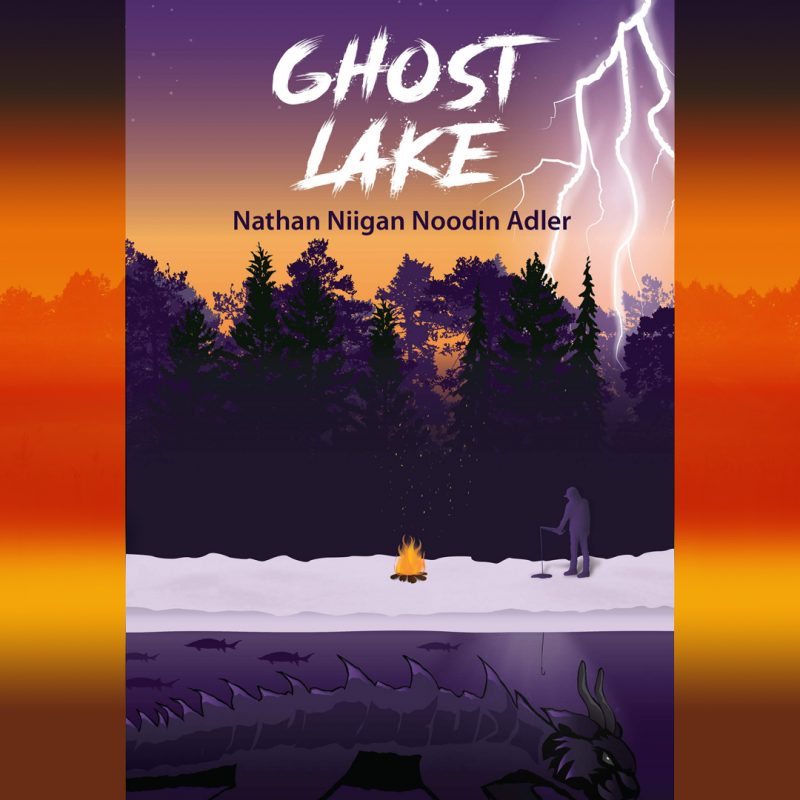USEREVIEW 084: Ghost Lake Survival Guide
In this thrilling and chilling experimental review, Emily Woodworth takes us on a knowing tour of the local lore, flora and fauna of Nathan Niigan Noodin Adler‘s Ghost Lake (Kegedonce Press, 2020).
ISBN 978-1-92812-024-7 | 307 pp | $19.95 CAD — BUY Here
#CAROUSELreviews
#USEREVIEWEDNESDAY
A Ghost Lake Guide to Survival
by
Ghost Lake Citizens for Tourism
So, you want to visit Ghost Lake. You’ve made an excellent choice! An exhilarating, backcountry paradise awaits, complete with its own local body of water, forests, snowmobiling in the winter, scenic burial grounds and good old-fashioned fun. But for an unprepared traveller, a trip to Ghost Lake can quickly go wrong. With help from local expert Nathan Niigan Noodin Adler, this guide will orient you on the dangers of traversing Ghost Lake with expert testimonies and case studies provided by those who have grown up in or around the area.
We will cover the following basic topics:
• Fire
• Weather
• Wildlife
• Shelter
By the end of this guide you will be well-prepared for any eventuality and ready to indulge in all that makes Ghost Lake a horrifying, complex, unmitigated pleasure to visit.
Fire
An absolute necessity for survival in any climate, fire is no less vital in Ghost Lake. Here, it acts not only as an agent of survival, but also as a gathering point for community revels and griefs, and, of course, as a danger, if used incorrectly. Fire is often present in a subtle way, more of a backdrop than a fixed focal point. However, there are local legends that wary travellers should take into account. In particular, if fire is turned to destructive purposes, Adler’s sources claim that perpetrators risk a unique curse: Fire is connected to an “Indian superstition,” Adler’s informant Gar says. According to Gar, his Nokomis (grandmother) always told him, “Don’t play with fire or you’ll wet the bed” (‘Incendiary’).
Weather
No matter how much experience you have — nature doesn’t always co-operate, sometimes she throws a blizzard or two out of left field. (‘Coyote’)
The lake is beautiful, but like all bodies of water, it is also dangerous. This one, more so than others. No matter how many precautions you take. (‘Sturgeon’)
For your journey to Ghost Lake, you should prepare yourself not just for inclement and dangerous weather, but also weather that assumes a living character of its own. This weather is particularly turbulent around the environs of the lake itself, where freak thunderstorms in summer, and icy accidents in winter, have claimed “lives through misfortune, carelessness, or just bad luck” (‘Sturgeon’). In Ghost Lake, nature is often hostile or, at the very least, unconcerned with human welfare. Simply ask local girl, Zaude, who knows the pain of losing a sibling to the ice of the lake. Or Kylie, who knew “better than to get complacent,” and yet faced a hair-raising experience on the waters of the lake. Or Fanon, a survivalist who “knows the land like the back of his hand,” yet becomes hopelessly lost in a blizzard.
More than merely being hot or cold, pleasant or bad, weather parallels the emotions of long-time Ghost Lake residents, who often interpret themselves through their environment. “My heart is as cold as the ice and snow. My heart is as unfeeling as the water that clogged his throat,” Zaude states. Fanon feels the weather as if it is another person actively participating in his experiences. He senses the weather’s wrath as “Vicious beads of ice blast any bits of exposed flesh,” and the snow — in a way that seems deliberate — battles against his progress toward safety and shelter during a blizzard. (Travellers caught in a similar situation may seek help among wildlife, like coyotes, although this carries its own perils [see ‘Wildlife’ below].)
For many residents cited by Adler, encounters with Ghost Lake’s natural world are not all bad. These almost primal encounters that force a confrontation with life-and-death circumstances seem to open spaces within them to create renewed relationships with ancient traditions. Uncommon meteorological occurrences become harbingers and warnings that hold new weight. Weather events may be accompanied not just by untimely death, but also by unsought returns to life. Through the weather and the land, the old world is made present in the new.
Visitors should make time to see the observatory, north of Ghost Lake, where “the uncommon lack of light pollution and the clarity of the night skies” can open a world of wonders by way of meteor showers and constellations (‘Valediction at the Star View Motel’). If you hear strange sounds while touring the lake, pause to listen, really listen, and you may just begin to hear yourself out in the world: “The sound comes again … A haunting sound; like a train, or an owl. A sound filled with longing and loneliness. But maybe I’m projecting” (‘Under the Ice’).
Whether lightning is striking twice on snowy days, or a creek bed is swelling to the level of a river at random, Ghost Lake is certainly not a passive environment, but an active participant in the events of locals’ lives. If you visit, remember this rule: “never go out on the lake if you’re not prepared to get wet” (‘Sturgeon’).
Wildlife
Below is a brief index of wildlife in the Ghost Lake area. Remember that wildlife are wild! Do not approach an unknown being without consulting this guide.
Bigfoot (Andookomeshiinh): Very rare creatures who seem shy of humans. A single sighting may send your mind into a spiral as you consider a world of new possibilities — like the legends of your elders being true.
Coyotes: Love to party, and always down for a good time. Sometimes appear as people, rather than canids. Join with them in their revels if you must, but beware, you may have regrets about the quality of their barbecue.
Crows: Are “always willing to accept an easy meal” and love humans for their wastefulness. Around Ghost Lake they are known to fly “across time as well as space.” Often seen travelling with dogs [see ‘Dog’ below]. Watchful over unsolved murders. If you encounter a crow, pay attention, and be sure to leave some scraps(!).
Creature of the Lake (Sturgeon): Although sightings are as-yet unconfirmed, be aware that locals insist there is something living in Ghost Lake’s depths. Reports of “grey-green scales” and unexplained “swells” that lift boats out of the water might be attributed to a very old, large sturgeon, methane gas leaks, or something undiscovered. In any case, if you spot the creature, proceeding out of the area is advised.
Dog: “Allow[s] himself to be owned by humans.” Identified by a mouth curved up in a perpetual smile. Often travels with crow [see ‘Crow’ above]. Poses no danger to humans unless provoked.
Jiibay (Ghost): Although not overly common, should you lose someone in a terrible way, or stray into a burial ground and (inadvertently, of course) steal something, prepare for a haunting. Some accounts have these beings arriving about seven days after their deaths. They are “semi-transparent — translucent really — like certain species of jellyfish,” and their “feet don’t touch the ground, they hover two inches above” (‘Hydrangeas’). Jiibay may or may not be malevolent.
Memengwesiag: Elusive creatures native to the Ghost Lake region. If you encounter a memengwesiag near the bluffs, it is recommended you DO NOT engage. They are clever, often tricking people who stray too close to their fishing grounds (most of whom are not heard from again). Memengwesiag can be difficult to identify, so keep this in mind, from our expert informer Zilpah: “Those little people don’t have any noses … And they have razor sharp teeth, strong enough to chew through a clothesline … After the garden was plowed, they’d come out to eat the churned-up grubs, just like dragonflies.” Memengwesiag are small and hard to see, with rough skin and “their wings inflate and deflate like lungs, and sound just like voices.”
Misaabe: Once common in the Ghost Lake area, Misaabe are now few. Although you may have an impulse to scream in horror if you see one, try to remember that they are large, gentle creatures who can easily have their feelings hurt.
Wiindigo: AVOID AT ALL COSTS. HIGH DANGER OF DEATH OR POSSESSION.
Shelter
The greatest shelter from the sometimes violent forces in Ghost Lake — whether natural or supernatural — is, by Adler’s account, family. When you encounter danger, doubt, grief, mysterious happenings, coming-of-age drama, or inexplicable apparitions, family will be your greatest resource. Of especial value are the aged of Ghost Lake, who know firsthand about the ancient ways and practices that can mollify — or anger — the active spirits that inhabit this region. Their wisdom and love will give you ample shelter from many types of storms.
Although Ghost Lake holds horrors and death, it also makes way for new life and ancient ways to intersect in an environment that is ripe for exhilaration and enjoyment. Many locals, especially the young people living in the area, who have faced trials have come out with more connections to the land and themselves, according to Nathan Niigan Noodin Adler. They’ve come to terms with grief and heartache, with lost loves and friends and family, and ultimately found themselves more conscious of their place in the ongoing story of their land, their lake and their people.
Those who enjoy their trip to Ghost Lake, should consider reading more about its history in Adler’s book Wrist.


